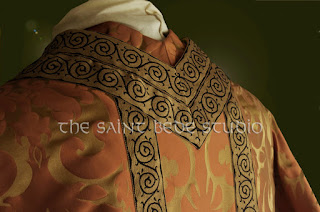The following is a translation of the Preface to a small liturgical book from times past titled the
Memoriale Rituum :
A Particular Congregation for determining certain matters concerning the Sacred Visitation of the parochial Churches in Rome was held by our Holy Father Pope Benedict XIII. on 4th December 1724.
The visible signs of religion and piety are rites and holy ceremonies by which the minds of the faithful are drawn to the contemplation of spiritual things.
His Holiness in the aforesaid Congregation confirmed a Decree ordering this Memoriale Rituum to be printed and to be observed by Rectors, in order that uniformity and exactness might be secured in the smaller parochial Churches in Rome, and at the same time to guard against omissions - by reasons of the fewness of clergy or insufficient knowledge of ceremonies - of those ceremonies by which our Holy Mother the Church brings to our remembrance the most noteworthy of [being]
the mysteries of the Passion.
The Memoriale combines exactness of rites with a very small number of servers. * Generally three are sufficient, four being seldom necessary. It is the duty of the parish Priest to give timely instruction to these servers, in order that that they may act quickly, but with attention, and so prevent aimless wandering to and fro.
He will teach them also those Psalms, Antiphons and Hymns which are to be recited or chanted in procession, endeavouring to obtain vocal uniformity; hence for greater convenience these Antiphons, etc., are inserted in the Memoriale, each in its own proper place, so that one and the same book contains directions as to what is to be done and also those Hymns, etc., which are to be recited.
Six functions occur in the course of each year are here set out :
Part I The Blessings of Candles on the Feast of the Purification of the Blessed Virgin Mary.Part II The Blessing of Ashes at the Beginning of Lent.Part III Palm Sunday.Part IV Thursday, the Day of the Lord's Supper.Part V The Friday of the Passover.Part VI Holy Saturday.
From these it will not be difficult to deduce a method for carrying out similar functions, so that in all things and at all times due regard for the sacred ceremonies may always be apparent.*
In the Latin, the term presumes the servers are clerics.Only 150 years after the publication of the
Missale Romanum by Pope S' Pius V, this interesting document describes the state of the Sacred Liturgy in the churches of the City of Rome. It would seem that, although the Rites of Holy Week - and other important Feasts of the Year to which were attached particular rites - were detailed in full in the
Missale Romanum, the observance of these Days had generally degenerated and required a reform.
What was intended as a Ritual guide to be observed only in the city of Rome, came to be used world-wide. It was especially important for missionary countries and rural churches which had but one priest and a small group of altar servers. This was a provision for smaller churches which did not have the means to celebrate these Rites in their fuller solemnity. It was a small book obviously intended to be hand held by the celebrant and his ministers. The
Memoriale Rituum was published in several editions and in translations, the last being published by the Holy See in 1950.
Noteworthy in this ritual guide is that, although it was preferred that the Rites would be sung, it was nevertheless permitted that they be read (either in part or entirely) or sung
recta tono with some inflections. The
Memoriale Rituum does not seem to envisage any choir chanting the rites - for example, the hymns, antiphons, psalms, but that they be chanted by the Celebrant and his ministers.
In the midst of the fashionable pre-occupation amongst Traditionalists at present with the use of the pre-1955 Rites of Holy Week, it is important to remember that the rites detailed in the
Memoriale Rituum were the
usual observance of Holy Week throughout the entire Church. In greater churches, monasteries &c., the more solemn celebration of these rites, as detailed in the editions of the
Missale Romanum would - of course - have been observed.
When the reformed rites of Holy Week were first celebrated in 1956, the rites as detailed in the
Memoriale Rituum were suppressed. Furthermore, the Restored Rites of 1956 allowed for a solemn or simple celebration of Holy Week,
but they were always to be sung : there was no permission for a form of Holy Week which was read.
















